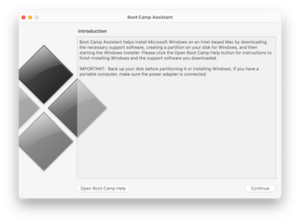Try legacy boot if EFI boot doesn't work. I have a delicate SSD pluged into one of the native SATA port. But can never install in EFI mode, even boot the installation disk to EFI will cause BSOD. And the bootcamp 5 Apple HFS driver is fine for Win 10. Boot Camp 5.1.5769 can be downloaded from our software library for free. Our antivirus analysis shows that this download is clean. The following versions: 5.1, 4.0 and 3.3 are the most frequently downloaded ones by the program users. The current setup file available for download requires 280.3 MB of hard disk space. 8/10 (22 votes) - Download Boot Camp Mac Free. If you're one of those people that use Windows on Mac with Boot Camp, you should download the latest update that includes all the drivers you need. Boot Camp is the solution offered by Apple so that Microsoft operating systems can be used on a system.
- Boot Camp 5.1 Dmg Download Mac
- Boot Camp 5.1 Dmg Download Torrent
- Boot Camp 5.1 Dmg Download Free
- Download Boot Camp 5.1 Dmg
Bootcamp is a software package Apple provides with each Mac OS X version. Bootcamp incorporates drivers and foundation software for Apple Mac hardware in Windows platform. You can set up a Windows partition from Mac using Bootcamp assistant. The most-recent variant of Bootcamp is 3.2 and is designed to work with Mac OS Snow Leopard. Apple is preparing to distribute Bootcamp 4.0 to in order to allow users install and dual boot Windows with the upcoming OS X Lion.
Boot Camp 5.1 Dmg Download Mac
You can download Bootcamp 4.0 from the OS X Lion interface. Find the Bootcamp Assistant using Spotlight search (Or from Application folder>Utilities>Bootcamp Assistant) and open the app from the list. Click on continue and in the next window, select to download 'Windows Support Software for this Mac' or Bootcamp 4.0, which is around 650MB in size. At the end, it will show option burn the file into to a CD or DVD.
In the next step, choose the required size of the Windows installation using the slider. Keep a minimum of 20GB for the partition and also note down its name and size. Now insert a genuine Windows 7 DVD and start installation.
Update: You may download latest bootcamp drivers 5 directly from Apple, here.
Windows 7 setup will load files and after sometime it will list the available disk partitions. Pick Bootcamp and click on the Drive Options (check below) and then format it. Now continue Windows installation on this partition.
Insert the Bootcamp 4.0 CD after completion. Open up Windows Explorer and browse through the disk, and execute setup.exe inside the Bootcamp folder. The application will install Graphics, sound and other system drivers (for Intel iMac, MacBook Pro, MacBook Air) and necessary software for Apple trackpad, Bluetooth, Magic mouse and other peripherals. Restart the system after installation. Upon start, press the Option key (alt) firmly for a few seconds. The bootloader will show the Mac OS X Lion and Windows 7 dual boot options.
Installing OS X Lion 10.7 above Snow Leopard 10.6.8 will not delete your existing Bootcamp partition. As shown in the screenshot, after installation you will get Mac OS X, Recovery HD and Bootcamp options. But I recommend you to take backup and I won't be responsible for any loss.
Update: Like the new versions of macOS requires USB drive for creating offline installer, the bootcamp downloader no longer supports DVDs.
Classic Mac Pro 5,1 (or simply cMP, also 4,1 upgraded to 5,1) is now considered by Apple as vintage. It's pretty disappointing considering how capable and upgradable these machines still are. Installing Windows is no longer officially supported, but it's completely possible though not quite easy.
Another challenge is that macOS Mojave 10.14 now implies using Metal-capable GPU while most of them are not able to display Apple boot menu (which you normally see holding the Option key) required to boot into Windows. Basicaly your screenremains black until macOS is loaded. Well, some EFI bootable cards that support boot menu exist but they are released almost 10 years ago and are really outdated. What is more, none of them supports displaying of boot menu with 4k 60hz monitor connected.
This guide is for those who want macOS Mojave + Windows 10 + modern GPU (in our case Sapphire Radeon Pulse RX 580 8GB).
Updated 28 May 2019
Installing Windows 10 in 5 steps
It's supposed that you have the latest Boot ROM version 144.0.0.0.0. If not, please update first.
Step 1: Use separate drive for Windows
Boot Camp Assistant no longer supports cMP and doesn't allow creating a separate partition for Windows.Windows has to be installed on a separate drive, which is good actually to avoid messing with partitions in future.
We recommend using the internal SATA II connector in one of four drive bays or alternatively one of two SATA II connectors in the optical drive area. Using the HP 654540-001 3.5' → 2.5' adapter (7$) to place 2.5' SSD in a drive bay can be quite convenient.

Of cause, SATA II (up to 300MB/s) is a bottleneck for modern 2.5' SSDs (up to 550 MB/s where SATA III is preferable) but real life experience shows that the difference is hardly noticable unless you deal with lots of big files (e.g. >1GB where sequential read/write speeds matter) on your system drive.
We didn't test using PCIe → SATA III adapter or PCIe → NVMe adapter for Windows partition. Many people reported it was not possible in their case. If you successfully did it please let us know in the comments below or via e-mail.
Step 2: Create a bootable Windows 10 DVD disk
Warning: DO NOT install Windows from a USB flash drive. It has been discovered that Windows when installed in EFI mode is corrupting the Mac Pro's firmware by signing it with multiple Secure Boot (X.509) certificates. Also, you wouldn't be able to boot into Windows after selecting its drive as bootable in macOS Preferences → Startup disk. Therefore Windows should only be installed in Legacy BIOS mode from an optical drive.
Make sure that your Windows 10 ISO file fits on the DVD disk, in our case we had to burn Windows 10 1803 ISO (64-bit) to a single-layer DVD+R disc 4.7GB.
Burning a DVD disk under macOS can be done with the following Terminal command:
On Windows we recommend using the free ImgBurn app.
Step 3: Boot from your Windows 10 DVD disk
Turn on your mac while holding the 'C' key to boot from the optical disk (if you have PCIe drives installed and can't boot from the disc, remove those PCIe adapters).Proceed with installation normally until you see the 'Where do you want to install Windows' drive selection screen.
Step 4: Format the target drive
Press Shift+F10 to launch command prompt. Type the following commands:
Now make sure to select the correct target drive number N (NOT your macOS disk), after that type:
You should now see your drive as Unallocated space.
Press the 'New' button to create necessary partitions. There should be only two partitions (for legacy installation, EFI mode creates four) automatically created:

Of cause, SATA II (up to 300MB/s) is a bottleneck for modern 2.5' SSDs (up to 550 MB/s where SATA III is preferable) but real life experience shows that the difference is hardly noticable unless you deal with lots of big files (e.g. >1GB where sequential read/write speeds matter) on your system drive.
We didn't test using PCIe → SATA III adapter or PCIe → NVMe adapter for Windows partition. Many people reported it was not possible in their case. If you successfully did it please let us know in the comments below or via e-mail.
Step 2: Create a bootable Windows 10 DVD disk
Warning: DO NOT install Windows from a USB flash drive. It has been discovered that Windows when installed in EFI mode is corrupting the Mac Pro's firmware by signing it with multiple Secure Boot (X.509) certificates. Also, you wouldn't be able to boot into Windows after selecting its drive as bootable in macOS Preferences → Startup disk. Therefore Windows should only be installed in Legacy BIOS mode from an optical drive.
Make sure that your Windows 10 ISO file fits on the DVD disk, in our case we had to burn Windows 10 1803 ISO (64-bit) to a single-layer DVD+R disc 4.7GB.
Burning a DVD disk under macOS can be done with the following Terminal command:
On Windows we recommend using the free ImgBurn app.
Step 3: Boot from your Windows 10 DVD disk
Turn on your mac while holding the 'C' key to boot from the optical disk (if you have PCIe drives installed and can't boot from the disc, remove those PCIe adapters).Proceed with installation normally until you see the 'Where do you want to install Windows' drive selection screen.
Step 4: Format the target drive
Press Shift+F10 to launch command prompt. Type the following commands:
Now make sure to select the correct target drive number N (NOT your macOS disk), after that type:
You should now see your drive as Unallocated space.
Press the 'New' button to create necessary partitions. There should be only two partitions (for legacy installation, EFI mode creates four) automatically created:
Boot Camp 5.1 Dmg Download Torrent
Select the newly created partition 2 and continue with installation normally. Your mac will be rebooted twice.Every reboot do not forget entering the boot menu (by holding the Option key) and selecting ‘Windows' boot drive there. When finished, boot into Windows.
Step 5: Install Windows drivers and Boot Camp utility
Windows 10 installs all necessary drivers automatically except Bluetooth and internal speaker. These need to be installed from the original Boot Camp package for MacPro5,1.Download and install 7zip, download Brigadier 0.2.4 app, open Windows command prompt where Brigadier is located and type:
When finished, it will create a folder BootCamp-031-11269, you need to install these for Bluetooth and internal speaker correspondingly, make sure you run the command prompt as administrator:
Now we need newer BootCamp drivers intended for iMacPro1,1:
When finished, it will create a folder BootCamp-041-55643, you need to run this command:
When finished, reboot. We also recommend running Apple Software Update to update Wifi drivers:
You probably don't want to forget installing our awesome Macs Fan Control app, do you? :)
Boot Camp 5.1 Dmg Download Free
Switching between macOS Mojave & Windows
When you're in macOS, use Preferences → Startup disk to select a boot drive:
When you're in Windows, use the Boot Camp Control Panel from your Windows tray to select a boot drive:
Download Boot Camp 5.1 Dmg
This guide is based on this MacRumors thread. Special thanks to h9826790 for sharing his useful experience. Any comments are welcome.
